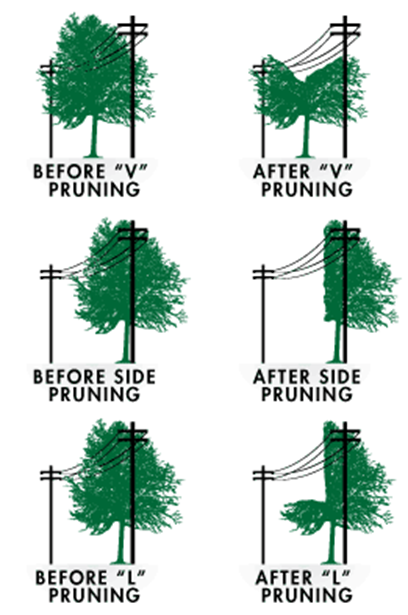Trees enhance the quality of life in every community through aesthetics and keeping the air clean by converting carbon dioxide to oxygen. However, trees and power lines don’t mix. Contact between them can cause power outages, fires, and downed lines, while also causing safety hazards for people, wildlife, and the trees themselves. To help keep power lines safe and reliable in your neighborhood, while ensuring the health of trees, Holyoke Gas and Electric's (HG&E) professional tree trimming contractors remove or carefully prune trees in areas to create minimum safe distances between electric lines and surrounding trees.
Throughout the course of the year, HG&E undertakes several vegetation management programs, which range from regularly scheduled trimming and pruning of trees, to removal of trees that are decayed, damaged, or weak.
Tree Trimming on Private Property
If a tree on private property is identified as a threat to power lines, HG&E or its contractors will either call you, speak with you in person, or provide you with advance written notice and an opportunity to discuss the project.
HG&E is not responsible for trimming or removing trees located on private property. If you are doing tree work on private property near electric service wires, please contact HG&E to evaluate the project. For your safety, a power line may need to be de-energized or dropped for a period of time.
If you have any questions about tree trimming services, please contact customer service.
Storm Damage and Debris
HG&E’s Vegetation Management Program (VMP) reduces the potential for outages and damage during a storm. However, the VMP does not cover the cleanup of trees and limbs that come down during a weather event. The removal and cleanup of debris (trees, limbs, etc.) on private property is the responsibility of the property owner. If an HG&E electrical wire comes down with the debris, our crews will remove the wire from the downed tree or limbs and reinstall it in its proper space.
HG&E Scheduled Trimming
To ensure safety and electric service reliability, HG&E schedules tree trimming every year adhering to the industry “best practices”. We only hire certified contractors to do this work.
Scheduled Maintenance Trimming is conducted on about 220 miles of electric lines each year many of which run along neighborhood streets, highways, backyards and alleyways. The scheduling cycle repeats every couple of years, or whenever HG&E feels that current site conditions deem it necessary to revisit a location. This trimming involves pruning trees below, along, and above wires to reduce the chances of tree-related outages. Our contractors remove limbs that are within 8 feet to either side, 10 feet below, and 15 feet above electric wires.
HG&E’s contractors utilize a technique called “directional pruning” in order to naturally “train” and direct growth away from the wires. This method is a true benefit to the health of the tree as it reduces disease and decay entry points. This pruning practice was developed in conjunction with the U.S. Forest Service and is endorsed by the International Society of Arboriculture, the National Arbor Day Foundation and other tree-care professionals around the world. Although directional pruning may not improve tree appearance, we believe it is a reasonable and responsible approach to keeping people and property safe and electric service reliable.
HG&E’s trimming is typically limited to tree branches that affect electric wires only. We do not trim trees or branches that affect phone or cable wires, although if warranted, we will at times trim around electric service lines.
Working efficiently as possible, we schedule trimming by geographic location. Unless there is a significant tree hazard affecting the electric wires in your area, we do not perform tree trimming outside of our trimming schedule. If there is a tree that you believe is a significant hazard to electrical wires, report it by contacting us.
Remember, you should never attempt to prune trees near power lines or hire an unqualified tree-trimming contractor to work within 10 feet of energized power lines.


